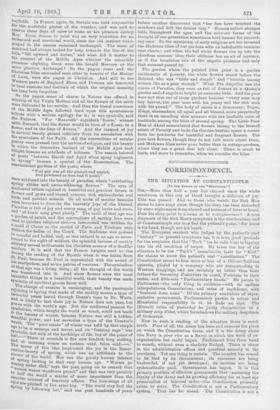IN THE TIME OF LILIES.
ONE of the commonest flowers in any herbaceous border is the beautiful, old-fashioned Madonna lily. There are many statelier and more gorgeous blossoms of the lily kind, but none sweeter, and then, too, the "Mary lily," as it is called in the North of England, has the added charm of association, for no picture of the Annunciation is complete unless a branch of these white pure blossoms stands up between Mary and the angel.
But it is only since the thirteenth century that painters have established the lily as the conventional symbol of the Madonna, for the earlier artists used to surround her with flowers of every sort and colour. It was not until compara- tively late that the symbolising instinct of a simple age felt that the ideal purity of the Lord's Mother was best expressed in the purity of white lilies, and so they were dedicated to her service.
The love of flowers is as old as the earth itself, and the pagan delight in roses and the change of seasons, in harvest and vintage, was a vital force that the Roman Catholic Church assimilated very easily and naturally without troubling herself about its origin,—the old ideas lived en under new names. The fire-worship of Midsummer Eve was turned to the honour of St. John; St. Valentine became the patron of the pairing season, which is older than the Catholic faith; St. Barnabas' Day was the signal for putting the scythe to the
hayfields. In Frame, again, St. Servals was held responsible for the malicious genius of the weather, and was said to reserve three days of snow to come at his pleasure during key. From demon to saint was an ensy transition for au unlearned and uncritical world, since the old Instinct which groped in the unseen remained unchanged. The sense of mankind had always looked for help towards the line of the bills, "lift upward and divine," and what did it matter to the peasant of the Middle Ages whether the unearthly Presence alighting there were the herald Mercury or the more glorious Archangel ? So the pagan roses and the Christian lilies succeeded each other in honour of the Mother of Love, were she pagan or Christian. And still in the Western parts of England Flora and Pomona are honoured in local customs and festivals of which the original meaning has long been forgotten. So the pagan sense of charm in Nature was offered in Worship of the Virgin Mother, and all the flowers of the earth were dedicated to her service. And then the literal conscience of the Middle Ages followed hard upon this spontaneous tribute with a serious apology for it; it was symbolic, said the Fathers. "For 'Nazareth' signifleth 'flower,' whence laitil Bernard, that the flower would be born of a flower, in a flower, and in the time of flowers." And the instinct of joy in natural beauty gained infinitely from its association with the symbolism of the Faith. All the conventions of smiler Poetry were pressed into the service of religion, and the beauty in which the decorative instinct of the Middle Ages took delight became an attribute of holiness. The season beloved of poets "between March and April when spray beginneth to spring" became a symbol of the Resurrection. The oonVentional gardens of the poets, where "Full gay was all the ground and quaint.
And powdered as men had it paint,"
Were sublimed into the beauty of paradise, where "everlasting ePring abides and never-withering flowers." The eyes of Mediaeval artists rejoiced in beautiful and gracious forms, in flowers and gems and chased armour, rich embroideries and birds and painted missals. So all sorts of secular beauties 'were borrowed to describe the heavenly joys of the blessed. Paradise is full of joy and merry song, of gay herbs and trees, and "of fowls' song great plenty." The earth of that age was a garden of saints, and the conventions of earthly love were Used to quicken religious zeitl,—a love-round was written for a maid of Christ as the stories of Paris and Tristram were written for ladies of the Court. The Madonna was praised la roundel and ballad, and, as was natural in an age so accus- tomed to the sight of soldiers, the splendid harness of earthly chivalry served to illustrate the Christian armour of a deadlier warfare. It is said that the French knights used to rise (.1.aring the reading of the Epistle when it was taken from t. Paul, because St. Paul is represented with the sword of ale rnartyrdoin, and so is a patron of warriors. The symbolism Of that ago was a living thing; all the thought of the world W55 translated into it. And since flowers were the most beautiful things in a beautiful world, their beauty was made aYmbolie of spiritual graces fairer still. The change of seasons is unchanging, and the passionate I:oioleing in spring that made of the earthly season a type of Immortal peace lasted through Dante's time to Dr. Watts, and ie likely to last, since joy in Nature does not pass, but grows with the world's age. But the mediaeval passion for !I7n1bolism, which taught the world so much, could not teach the beauty of winter, because Nature was still a hidden, dreadful power, and her severities a type of the Creator's varrath. The "poor estate" of winter was held by that simple age to be a scourge and terror, and its "freezing rage" was
:ell
.Ymbolio, not only of the hardships of life, but of the pains of :—" There at eventide is fire new kindled, long abiding, „,"11,c1 at morning comes an eastern wind, felon cold—." 0 terror of this idea heightened the joy in the Resur- tion-beauty of spring, which was an antithesis to the !°,rrow of the world. Nor was the purely human interest °I spring lacking in that very human age. "Worms go **(a:411g under clod," says the poet, going on to remark that waxen wondrous proud," and that was very possibly to half the world a matter of more importance than the a meter interest of heavenly affairs. The love-songs of all ages at•e Pitched in the same key. "Tile world may find the Pring by following her," said one poet hundreds of years before another diecovered that ' her feet have touched the meadows and left the daisies rosy." Human nature changes little throughout the ages,. and the outworn forma of the thought of one generation sometimes hold lessons for succeed- ing ones. So the mysticism of early religious art has invested the Madonna lilies of our gardens with an indefinable reminis-, cent charm; and when the tall white flowers rise up into the cloudless summer blue, their stillness has an air of mystery, as if the breathless stir of the angelic presence had only that moment passed by. The garden where the painted lilies grow is a garden emblematic of poverty, the white flowers stand before the Beloved who was "little and simple" and "humble among women like as a poor woman." When Fin Angelico saw the courts of Paradise, they were as full of flowers as a Queen's garden and of angels as bright as anemone beds. And the poor were not shut out of those gardens because "every man may buy heaven, the poor man with his penny and the rich man with his pound." The body of saints is a democracy; Popes, Kings, shoemakers, all equal and all blessed, move perpetually there in an unending slow measure with the ineffable calm of beatitude, among the lilies of eternal spring. The Little Poor Man of Assisi remembered that flowers belong to the blessed estate of Poverty and bade the Garden-brother spare a corner from his pot-herbs for beautiful and fragrant flowers. The poor love flowers, though they do not talk much about them, and Madonna lilies never grow better than in cottage-gardens, where they are a great deal left alone. There is much to learn, and more to remember, when we consider the lilies.







































 Previous page
Previous page